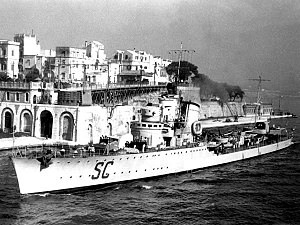Italian destroyer Scirocco
 Scirocco
| |
| History | |
|---|---|
| Name | Scirocco |
| Namesake | Sirocco |
| Builder | Cantiere navale di Riva Trigoso |
| Laid down | 29 September 1931 |
| Launched | 22 April 1934 |
| Completed | 21 October 1934 |
| Fate | Sank in a storm, 23 March 1942 |
| General characteristics (as built) | |
| Class and type | Maestrale-class destroyer |
| Displacement | |
| Length | 106.7 m (350 ft 1 in) |
| Beam | 10.15 m (33 ft 4 in) |
| Draught | 3.31–4.3 m (10 ft 10 in – 14 ft 1 in) |
| Installed power |
|
| Propulsion | 2 shafts; 2 geared steam turbines |
| Speed | 32–33 knots (59–61 km/h; 37–38 mph) |
| Range | 2,600–2,800 nmi (4,800–5,200 km; 3,000–3,200 mi) at 18 knots (33 km/h; 21 mph) |
| Complement | 190 |
| Armament |
|
Scirocco was one of four Maestrale-class destroyers built for the Regia Marina (Royal Italian Navy) in the early 1930s. Completed in 1934, she served in World War II.
Design and description[edit]
The Maestrale-class destroyers were a completely new design intended to rectify the stability problems of the preceding Folgore class.[1] They had a length between perpendiculars of 101.6 meters (333 ft 4 in) and an overall length of 106.7 meters (350 ft 1 in). The ships had a beam of 10.15 meters (33 ft 4 in) and a mean draft of 3.31 meters (10 ft 10 in)[2] and 4.3 meters (14 ft 1 in) at deep load.[1] They displaced 1,640 metric tons (1,610 long tons) at standard load, and 2,243 metric tons (2,208 long tons) at deep load.[3] Their complement during wartime was 190 officers and enlisted men.[4]
The Maestrales were powered by two Parsons geared steam turbines, each driving one propeller shaft using steam supplied by a trio of three-drum boilers.[4] The turbines were designed to produce 44,000 shaft horsepower (33,000 kW) and a speed of 32–33 knots (59–61 km/h; 37–38 mph) in service, although the ships reached speeds of 38–39 knots (70–72 km/h; 44–45 mph) during their sea trials while lightly loaded. They carried enough fuel oil to give them a range of 2,600–2,800 nautical miles (4,800–5,200 km; 3,000–3,200 mi) at a speed of 18 knots (33 km/h; 21 mph) and 690 nmi (1,280 km; 790 mi) at a speed of 33 knots (61 km/h; 38 mph).[1]
Their main battery consisted of four 120-millimeter (4.7 in) guns in two twin-gun turrets, one each fore and aft of the superstructure.[3] Amidships were a pair of 15-caliber 120-millimeter star shell guns. Anti-aircraft (AA) defense for the Maestrale-class ships was provided by four 13.2-millimeter (0.52 in) machine guns. They were equipped with six 533-millimeter (21 in) torpedo tubes in two triple mounts amidships. Although the ships were not provided with a sonar system for anti-submarine work, they were fitted with a pair of depth charge throwers.[1] The Maestrales could carry 56 mines.[3]
Citations[edit]
Bibliography[edit]
- Brescia, Maurizio (2012). Mussolini's Navy: A Reference Guide to the Regina Marina 1930–45. Annapolis, Maryland: Naval Institute Press. ISBN 978-1-59114-544-8.
- Fraccaroli, Aldo (1968). Italian Warships of World War II. Shepperton, UK: Ian Allan. ISBN 0-7110-0002-6.
- Roberts, John (1980). "Italy". In Chesneau, Roger (ed.). Conway's All the World's Fighting Ships 1922–1946. New York: Mayflower Books. pp. 280–317. ISBN 0-8317-0303-2.
- Rohwer, Jürgen (2005). Chronology of the War at Sea 1939–1945: The Naval History of World War Two (Third Revised ed.). Annapolis, Maryland: Naval Institute Press. ISBN 1-59114-119-2.
- Whitley, M. J. (1988). Destroyers of World War 2: An International Encyclopedia. Annapolis, Maryland: Naval Institute Press. ISBN 1-85409-521-8.
External links[edit]
- Scirocco Marina Militare website
